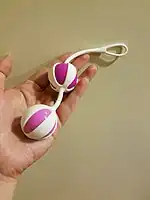Pelvic floor muscle exercise
| Pelvic floor muscle exercise | |
|---|---|
| Other names: Kegel exercise; pelvic floor exercise; pelvic muscle exercise; pelvic muscle training; pelvic floor physiotherapy; pelvic floor rehabilitation | |
 | |
| Diagram of pelvic floor exercises | |
| Pronunciation |
|
| Specialty | Urology, gynecology |
| Indications | Urinary incontinence, pelvic organ prolapse[1][2] |
| Steps | 1) Squeeze pelvic floor muscles[3] 2) Hold for 3 seconds[3] 3) Release and fully relax[3] 4) Repeat 10 to 15 times, three times per day[3] |
Pelvic floor muscle exercise (PFME), also known as Kegel exercises, are exercises used to manage overactive bladder, urinary incontinence, and pelvic organ prolapse.[1][2] It is a first line treatment for stress urinary incontinence.[1] They may also help with sexual function.[3] Both males and females may benefit.[3] It often requires 3 to 6 weeks for benefits to occur.[3]
It involves repeatedly contracting, holding for 3 seconds, and then relaxing the muscles that form the pelvic floor.[2][3] It may be combined with biofeedback devices and done in combination with bladder training.[4][2] Carrying out the exercises while lying, standing, and sitting is recommended.[3] The exercises should be done as three sets of 10 to 15 repeats per day.[3]
Care is recommended to not contract abdominal muscles or thigh muscles during the exercises.[3] Excessive exercises are also discouraged.[3] The pelvic floor muscles support the bladder, rectum, and uterus.[3] Modern descriptions date from 1936 in the United Kingdom by physiotherapist Margaret Morris.[5] It was subsequently popularized by American gynecologist Arnold Kegel in 1948.[1][6] Descriptions of pelvic exercises; however, go back thousands of years.[5]
Health effects
Urinary incontinence
Pelvic floor exercises can be included in conservative treatment approaches for women with urinary incontinence.[7] There is tentative evidence that biofeedback may give added benefit when used with pelvic floor muscle training (PFMT).[8] There is no clear evidence that teaching pelvic floor exercises alters the risk of stress urinary incontinence in men that develop this condition post prostatectomy.[9]
In pregnant women, antenatal PFMT probably helps prevent urinary continence during pregnancy and up to six months after giving birth but for pregnant women who already have incontinence, it is not clear if antenatal PFMT helps to reduce symptoms.[10]
Factors such as pregnancy, childbirth, aging, and being overweight often weaken the pelvic muscles.[11] This can be assessed by either digital examination of vaginal pressure or using a Kegel perineometer. Kegel exercises are useful in regaining pelvic floor muscle strength in such cases.[12]
Pelvic organ prolapse
The symptoms of prolapse and its severity can be decreased with pelvic floor exercises.[13][14] Effectiveness can be improved with feedback on how to do the exercises.[15]
Fecal incontinence
In pregnancy, it is not yet clear if antenatal PFMT helps to prevent or treat fecal incontinence.[10]
Men
Premature ejaculation is defined as when male ejaculation occurs after less than one minute of penetration.[16] The perineal muscles are involved in ejaculation when they are involuntarily contracted.[17] The ischiocavernosus muscle is responsible for male erection, and the bulbocavernosus muscle is responsible for ejaculation. By actively contracting the perineal muscles with Kegel exercises regularly, strength and control of these muscles increase, possibly aiding in avoidance of premature ejaculation.[17][18]
Mechanism of action
Kegel exercises aim to improve muscle tone by strengthening the pubococcygeus muscles of the pelvic floor. Kegel is a popular prescribed exercise for pregnant women to prepare the pelvic floor for physiological stresses of the later stages of pregnancy and childbirth. Various advisors recommend Kegel exercises for treating vaginal prolapse[19] and preventing uterine prolapse[20] in women and for treating prostate pain and swelling resulting from benign prostatic hyperplasia (BPH) and prostatitis in men. Kegel exercises may have benefits in treating urinary incontinence in both men and women.[21] Kegel exercises may also increase sexual gratification, allowing women to complete pompoir and aiding men in reducing premature ejaculation.[22] The many actions performed by Kegel muscles include holding in urine and avoiding defecation. Reproducing this type of muscle action can strengthen the Kegel muscles. The action of slowing or stopping the flow of urine may be used as a test of correct pelvic-floor exercise technique.[23][14]
The components of levator ani (the pelvic diaphragm), namely pubococcygeus, puborectalis and iliococcygeus, contract and relax as one muscle.[24] Hence pelvic-floor exercises involve the entire levator ani rather than pubococcygeus alone. Pelvic-floor exercises may help in cases of fecal incontinence and in pelvic organ prolapse conditions e.g. rectal prolapse.[25]
Kegel exercises can train the perineal muscles by increasing oxygen supply and the strength of those muscles.[17] The names of the perineal muscles are: ischiocavernosus (erection), bulbocavernosus (ejaculation), external sphincter of the anus, striated urethral sphincter, transverse perineal, levator of the prostate, and puborectalis.[10]
Devices
Some devices, marketed to women, are for exercising the pelvic floor muscles and to improve the muscle tone of the pubococcygeal or vaginal muscle.
As of 2013 there was no evidence that doing pelvic floor exercise with weights worked better than doing Kegel exercises without weights; there is greater risk with weights, because a foreign object is introduced into the vagina.[26][27]
 A Kegel exerciser
A Kegel exerciser Jade eggs (or Yoni eggs) have been marketed for use in vaginal weightlifting.
Jade eggs (or Yoni eggs) have been marketed for use in vaginal weightlifting. Ben wa balls
Ben wa balls
Marketing
During the latter part of the 20th century, a number of medical and pseudo-medical devices were marketed to consumers as improving sexual performance or orgasms, increasing "energy", "balancing hormones", and as having other health or lifestyle benefits. There is no evidence for any of these claims, and many of them are pseudoscience.[28][29]
See also
- Pelvic floor physical therapy
- Taoist sexual practices
- Vacuum exercise
- Vaginal steaming
References
- 1 2 3 4 Cho, ST; Kim, KH (December 2021). "Pelvic floor muscle exercise and training for coping with urinary incontinence". Journal of exercise rehabilitation. 17 (6): 379–387. doi:10.12965/jer.2142666.333. PMID 35036386.
- 1 2 3 4 Lamin, E; Parrillo, LM; Newman, DK; Smith, AL (February 2016). "Pelvic Floor Muscle Training: Underutilization in the USA". Current urology reports. 17 (2): 10. doi:10.1007/s11934-015-0572-0. PMID 26757904.
- 1 2 3 4 5 6 7 8 9 10 11 12 13 "Kegel Exercises | NIDDK". National Institute of Diabetes and Digestive and Kidney Diseases. Archived from the original on 2018-04-22. Retrieved 2017-12-02.
 This article incorporates text from this source, which is in the public domain.
This article incorporates text from this source, which is in the public domain. - ↑ Newman, DK (July 2014). "Pelvic floor muscle rehabilitation using biofeedback". Urologic nursing. 34 (4): 193–202. PMID 25233622.
- 1 2 Simpson, Jane (30 May 2019). The Pelvic Floor Bible: Everything You Need to Know to Prevent and Cure Problems at Every Stage in Your Life. Penguin UK. p. PT18. ISBN 978-0-241-38654-5. Archived from the original on 22 October 2023. Retrieved 20 October 2023.
- ↑ Cameron, Anne P. (20 January 2022). Female Urinary Incontinence. Springer Nature. p. 126. ISBN 978-3-030-84352-6. Archived from the original on 22 October 2023. Retrieved 20 October 2023.
- ↑ Dumoulin, Chantale; Cacciari, Licia P.; Hay-Smith, E. Jean C. (2018-10-04). "Pelvic floor muscle training versus no treatment, or inactive control treatments, for urinary incontinence in women". The Cochrane Database of Systematic Reviews. 2018 (10): CD005654. doi:10.1002/14651858.CD005654.pub4. ISSN 1469-493X. PMC 6516955. PMID 30288727.
- ↑ Herderschee R, Hay-Smith EJ, Herbison GP, Roovers JP, Heineman MJ (6 July 2011). "Feedback or biofeedback to augment pelvic floor muscle training for urinary incontinence in women". The Cochrane Database of Systematic Reviews (7): CD009252. doi:10.1002/14651858.CD009252. PMID 21735442.
- ↑ Anderson, Coral A.; Omar, Muhammad Imran; Campbell, Susan E.; Hunter, Kathleen F.; Cody, June D.; Glazener, Cathryn M. A. (2015-01-20). "Conservative management for postprostatectomy urinary incontinence". The Cochrane Database of Systematic Reviews. 1 (1): CD001843. doi:10.1002/14651858.CD001843.pub5. hdl:2164/6141. ISSN 1469-493X. PMC 7025637. PMID 25602133.
- 1 2 3 Woodley, SJ; Lawrenson, P; Boyle, R; Cody, JD; Mørkved, S; Kernohan, A; Hay-Smith, EJC (6 May 2020). "Pelvic floor muscle training for preventing and treating urinary and faecal incontinence in antenatal and postnatal women". The Cochrane Database of Systematic Reviews. 5 (3): CD007471. doi:10.1002/14651858.CD007471.pub4. PMC 7203602. PMID 32378735.
- ↑ Services, Department of Health & Human. "Pelvic floor". Archived from the original on 2018-02-22. Retrieved 2018-02-21.
- ↑ Mentor, Physio (2022-10-15). "Kegel Exercises- Pelvic Floor Muscles Strengthening". Physiomentor. Archived from the original on 2022-10-15. Retrieved 2022-10-16.
- ↑ Hagen S, Stark D (2011). "Conservative prevention and management of pelvic organ prolapse in women". Cochrane Database Syst Rev. 12 (12): CD003882. doi:10.1002/14651858.CD003882.pub4. PMID 22161382.
- 1 2 "Cystocele (Prolapsed Bladder) | NIDDK". National Institute of Diabetes and Digestive and Kidney Diseases. Archived from the original on 2017-10-04. Retrieved 2017-12-02.
- ↑ Herderschee, R; Hay-Smith, EJ; Herbison, GP; Roovers, JP; Heineman, MJ (6 July 2011). "Feedback or biofeedback to augment pelvic floor muscle training for urinary incontinence in women". The Cochrane Database of Systematic Reviews (7): CD009252. doi:10.1002/14651858.CD009252. PMID 21735442.
- ↑ Goldstein, Sam; Naglieri, Jack A., eds. (2011). Encyclopedia of child behavior and development. [New York]: Springer. ISBN 9780387790619. OCLC 704395400.
- 1 2 3 Puppo, Vincenzo; Puppo, Giulia (January 2016). "Comprehensive review of the anatomy and physiology of male ejaculation: Premature ejaculation is not a disease: Anatomy and Physiology of Ejaculation". Clinical Anatomy. 29 (1): 111–119. doi:10.1002/ca.22655. PMID 26457680. S2CID 9213013.
- ↑ Puppo, V.; Abdulcadir, J.; Mannucci, A.; Catania, L.; Abdulcadir, D. (April 2008). "T09-P-13 The importance of the Kegel exercises for the erection of the male and female erectile organs (male and female penis)". Sexologies. 17: S136. doi:10.1016/s1158-1360(08)72894-9. ISSN 1158-1360.
- ↑ September 2, 2011 (2011-02-09). "Vaginal Prolapse". eMedicineHealth. Archived from the original on 2006-07-21. Retrieved 2011-09-02.
- ↑ "MedlinePlus Medical Encyclopedia: Uterine prolapse". Nlm.nih.gov. 2011-08-29. Archived from the original on 2001-08-20. Retrieved 2011-09-02.
- ↑ "MedlinePlus Medical Encyclopedia: Kegel exercises". Nlm.nih.gov. 2011-08-29. Archived from the original on 2001-06-17. Retrieved 2011-09-02.
- ↑ La Pera, G; Nicastro, A (1996). "A new treatment for premature ejaculation: the rehabilitation of the pelvic floor". Journal of Sex & Marital Therapy. 22 (1): 22–6. doi:10.1080/00926239608405302. PMID 8699493.
- ↑ Kenway, M., and Goh, J. (2009). Inside Out: The Essential Women's Guide to Pelvic Support.
- ↑ Gowda, Supreeth N.; Bordoni, Bruno (2022). "Anatomy, Abdomen and Pelvis, Levator Ani Muscle". StatPearls. StatPearls Publishing. PMID 32310538. Archived from the original on 9 November 2022. Retrieved 11 May 2022.
- ↑ Bø, K (2006). "Can pelvic floor muscle training prevent and treat pelvic organ prolapse?". Acta Obstet Gynecol Scand. 85 (3): 263–8. doi:10.1080/00016340500486800. PMID 16553172. S2CID 221452341.
- ↑ Herbison, GP; Dean, N (8 July 2013). "Weighted vaginal cones for urinary incontinence". The Cochrane Database of Systematic Reviews. 2013 (7): CD002114. doi:10.1002/14651858.CD002114.pub2. PMC 7086390. PMID 23836411.
- ↑ "A randomised controlled trial of the PelvicToner Device in female stress urinary incontinence". BJUI.org. Archived from the original on 2011-09-27. Retrieved 2011-09-02.
- ↑ Tuteur, Amy (18 December 2008). "Vaginal weight lifting". The Skeptical OB. Archived from the original on 8 November 2022. Retrieved 4 September 2023.
- ↑ "No, Gwyneth Paltrow, women should not put jade eggs in their vaginas, gynecologist says". Washington Post. Archived from the original on 12 February 2021. Retrieved 6 February 2017.
External links
- Mayo Clinic - Kegel Exercises for Men Archived 2023-09-06 at the Wayback Machine
- Kegel Exercises: Treating Male Urinary Incontinence Archived 2012-10-22 at the Wayback Machine